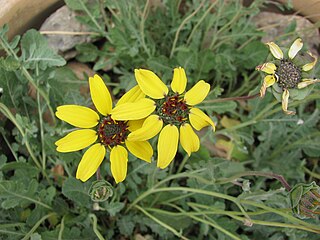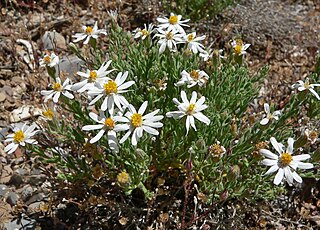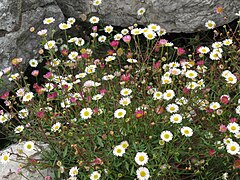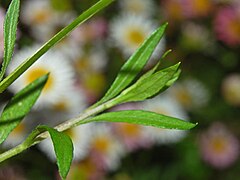
Erigeron is a large genus of plants in the composite family (Asteraceae). It is placed in the tribe Astereae and is closely related to the Old World asters (Aster) and the true daisies (Bellis). The genus has a cosmopolitan distribution, but the highest diversity occurs in North America.

Erigeron compositus is an Arctic and alpine species of fleabane in the family Asteraceae. Common names include dwarf mountain fleabane, cutleaf daisy, and trifid mountain fleabane.

Berlandiera is a genus of flowering plants in the family Asteraceae.

Erigeron annuus, the annual fleabane, daisy fleabane, or eastern daisy fleabane, is a species of herbaceous, annual or biennial flowering plant in the family Asteraceae.

Chaetopappa is a genus of plants in the family Asteraceae which are known generally as leastdaisies.

Erigeron strigosus is a species of flowering plant in the family Asteraceae known by the common names prairie fleabane, common eastern fleabane, and daisy fleabane.

Layia is a genus of flowering plants in the family Asteraceae known generally as tidy tips, native to western North America. Several are California endemics.
Amblyolepis is a genus of flowering plants in the daisy family described as a genus in 1836.

Olearia elliptica, commonly known as the sticky daisy bush, is a shrub in the family Asteraceae and is native to New South Wales and Queensland in eastern Australia. It has scattered, sticky leaves and white flowers in summer and autumn.

Erigeron aureus, the Alpine yellow fleabane, is a species of flowering plant in the family Asteraceae, native to the Cascades and Rocky Mountains of northwestern North America. The specific epithet aureus means "golden yellow".

Erigeron arenarioides is a species of flowering plant in the family Asteraceae known by the common names sand fleabane and Wasatch fleabane. It has been found only in the northern part of the state of Utah in the western United States.

Erigeron speciosus is a widespread North American species of flowering plants in the family Asteraceae known by the common names aspen fleabane, garden fleabane, and showy fleabane.
Erigeron tenellus is a North American species of flowering plant in the family Asteraceae known by the common name Río Grande fleabane. It is native to the valley of the Río Grande, on both sides of the international border. It is found in the US state of Texas as well as in Nuevo León and Tamaulipas in México.

Erigeron tweedyi, or Tweedy's fleabane, is a perennial herb in the family Asteraceae. It is native to the Rocky Mountains in Montana, Idaho and Wyoming.
Felicia cana is a low and slender shrublet of up to 15 cm high, covered in white felty hairs, that is assigned to the family Asteraceae. It has alternately arranged leaves, and flower heads of about 16 mm (0.63 in) across, with 3–4 whorls of involucral bracts, and about 20 blue purple ray florets, surrounding many yellow disc florets in the centre. Very characteristic for the species are also the middle-long hairs with forked tips on the surface of its fruits. It is an endemic species that is restricted to a zone along the southern coast of the Western Cape province of South Africa.
Olearia chrysophylla is a species of flowering plant in the family Asteraceae and is endemic to eastern Australia. It is a shrub with scattered elliptic leaves, and white and yellow, daisy-like inflorescences.

Olearia cydoniifolia is a species of flowering plant in the family Asteraceae and is endemic to eastern Australia. It is a shrub with scattered elliptic leaves, and white and yellow, daisy-like inflorescences.
Olearia elaeophila is a species of flowering plant in the family Asteraceae and is endemic to the south-west of Western Australia. It is a small shrub with scattered linear leaves, and white or blue and yellow, daisy-like inflorescences.
Olearia hygrophila, commonly known as swamp daisy or water daisy, is a species of flowering plant in the family Asteraceae and is endemic to a restricted part of North Stradbroke Island in south-eastern Queensland. It is a shrub with slender stems, linear leaves and white and yellow, daisy-like inflorescences.

Olearia ramosissima, commonly known as much-branched daisy bush, is a species of flowering plant in the family Asteraceae and is endemic to continental Australia. It is a straggly shrub with densely-crowded, elliptic, egg-shaped or triangular leaves, and blue to violet and blue or yellow, daisy-like inflorescences.


















